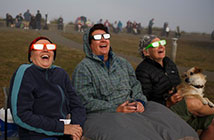2017年,我们了解到哪些科学新知?
|
世界上每年都有多项科学新进展,很难讲哪一项是最重要的。但如果要在2017年的科学新知中选择一些亮点的话,《纽约时报》分享了以下这些令人难忘的事件和新发现。
The Great American Eclipse We learned that nothing brings people together like the sun hiding behind the moon. On Aug 21, the country came to a pause as millions of Americans — even the president — put on eclipse glasses and stopped to take in the first eclipse to cross the United States since 1918. Its path across the United States was a scientific bonanza for astronomers who were able to more easily point advanced equipment at the sun. What Separates Wolves From Dogs
James Gorman, a Times reporter, accompanied scientists who are trying to understand the genes that distinguish dogs from wolves. Humans who raise wolf puppies must spend 24 hours a day, seven days a week with them in order to socialize these puppies for scientific study. And while the pups may seem cute, they will grow to be predatory wolves, not humanity’s faithful companions. The researchers hope their work will help reveal the trigger that made some ancient wolves into the dogs we know today. Treating Birth Defects Before a Baby Is Born
A Times reporter, Denise Grady, went inside an operating room to observe an experimental technique to treat severe spina bifida in a 24-week-old fetus. The doctors performing the surgery hope it will result in superior outcomes for children born with the disorder. Their first 28 surgeries have seen good results so far. Jan. 14 is the due date for the mother who was the subject of the article. Farewell to Cassini
The Cassini spacecraft has been sending home images of Saturn, its rings and its moons since arriving at the gas giant in 2004. The mission ended in September with a planned fiery crash into Saturn’s atmosphere. While it studied the planet, Cassini explored moons — Titan and Enceladus — that could be home to extraterrestrial life. The probe also gave us great insight into our solar system, and will continue to do so for years as scientists pore over the data it collected. Beauty and Evolution
Why does beauty exist? To answer this question, Richard O. Prum, an ornithologist, is working to revive an idea advanced by Charles Darwin: the attractiveness of an animal to another of its species isn’t only tied to fitness and good genes. Rather, animals — especially birds in Dr. Prum’s work — are making subjective decisions. He hopes that evolutionary biologists will stop “explaining away desire.” Saving Cancer Patients in Africa
Major pharmaceutical companies, working with the American Cancer Society, will steeply discount cancer drugs for patients in African countries. Cancer kills 450,000 people across the continent each year, but many types here are among the most treatable: breast, cervical and prostate tumors. The Global Obesity Epidemic
Makers of processed food, soda and fast food see markets in the developing world as their greatest growth opportunities. At the same time, obesity rates and weight-related illnesses are on the rise in developing countries. An ongoing series of articles examined the interaction of these two trends, starting with cases in Brazil, Ghana and Colombia. Taken together, these stories reveal “a new global food order, and a new health crisis.” Where Goods Made From Trafficked Wildlife Go
When contraband goods made from prohibited wildlife are seized in the United States, they find their way to the National Wildlife Property Repository near Denver. Pictures taken by Tristan Spinski from inside the facility — shoes made of leopard skin, a lamp made with zebra hooves, a sea turtle’s skull, an elephant foot stool — “testify to the human appetite for other species,” Rachel Nuwer wrote for The Times in July. The Aftermath of Zika Virus
Late last year, the World Health Organization declared that Zika virus was no longer a global emergency. But the disease’s effects on babies who may live for decades are only beginning to be understood. In northeastern Brazil, where links between the virus and birth defects like microcephaly were first detected, families struggle to give the best lives possible to stricken babies. Researchers hope to find clues about the virus’s effects on the fetus by studying pairs of twins in Brazil in which one was born with birth defects and the other was not. Colliding Neutron Stars
Astronomers confirmed a key part of Einstein’s general theory of relativity in 2016 when they announced that the LIGO array had detected gravitational waves released by the collision of two black holes. The researchers won a Nobel Prize for the discovery. But they’re not done: In October, scientists announced the finding of two dead stars colliding — not only hearing the ripples in space-time they made, but confirming the event visually with powerful telescopes. Collisions of neutron stars are believed to be the source of all heavy metals in the universe, including gold and silver, and the detection by LIGO helps verify accepted explanations of how the chemistry of the universe formed. |









